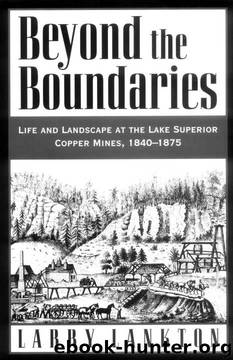Beyond the Boundaries: Life and Landscape at the Lake Superior Copper Mines, 1840-1875 (Michigan) by Larry Lankton

Author:Larry Lankton [Larry Lankton]
Language: eng
Format: epub
Published: 2008-05-25T08:45:00+00:00
By the mid-187os, 8,250 adult males lived and worked in Keweenaw, Ontonagon, and Houghton counties (including Isle Royale). Sixty-five percent of them-5,35o men-worked in the copper industry: in the mines, the surface shops and offices, the stamp mills, the Portage Lake smelter. Michigan's state census of 1874 reported that a considerable number of skilled tradesmen worked in the region: about 21o blacksmiths, machinists, mechanics, pattern makers, or moulders. The building trades were well represented, too: over 350 men worked as carpenters, joiners, painters, masons, bricklayers, and plasterers."
In a land of forests, where wood, a wonderfully versatile material, was put to so many uses by a new industrial society, it was not surprising that many men made their living with saws and axes. The population included about 450 men who worked as loggers, woodchoppers, lumbermen, sawyers, hewers, and wood dealers. Others made a living off nature-forests, fields, lakes, and streams-in different ways: the census counted nearly two hundred farmers, and seventy-five fishermen, hunters, and trappers.
Much heavy material moved across the Keweenaw. Supplies came in, copper went out, people moved about. The place was still in transition between the horse age and the steam age, and a number of men occupied themselves by outfitting and keeping horses (thirty harness makers, saddlers, wagon makers, wheelwrights, hostlers and livery keepers) and driving horses (over two hundred teamsters and stage drivers). Of course, people got around on foot, too, and a surprisingly high number of shoemakers-sixty of them-made the Keweenaw their home. (Perhaps so many were needed to make and repair miners' special hobnailed boots.)
The Keweenaw's towns supported nearly sixty hotelkeepers and boardinghouse keepers; as many barbers as lawyers (eleven each); thirty physicians, six druggists and three dentists. A man who smoked and drank as a respite from his workaday world could deal with any one of seven cigar makers or tobacconists, and tip drinks across the bar from eighty men earning their way as saloon keepers.
In the i86os and early 1870s, Houghton County paid men to perform a host of miscellaneous jobs: repair bridges, build fences, transport prisoners, kill wolves, build coffins, dig paupers' graves, transport the ill to quarantine, serve on inquests, join a sheriff's posse, and bring in dead bodies. As for the few women who worked for the county, Mrs. Nolan got paid for "cleaning jail" and Mary McCarthy and Ellen Dunn for "cleaning courtroom" and "scrubbing courthouse." Gertrude Post received the unenviable assignment of "Nurse employed in Pest House.";'
Women up on Lake Superior had far fewer ways to earn an income than men. For many women, and for girls, working outside the home usually meant working inside somebody else's. Well-to-do women eased their domestic burdens by hiring other women to do household chores. "Domestics," or servants, who could either live in or live out, performed a wide range of chores, virtually anything that the woman of the house wanted done: getting up early to light the stove, cooking, cleaning, sewing, laundry, tending the children.
Instead of hiring out full-time as a domestic to one household, some women took in cleaning or sewing jobs from a variety of neighbors.
Download
This site does not store any files on its server. We only index and link to content provided by other sites. Please contact the content providers to delete copyright contents if any and email us, we'll remove relevant links or contents immediately.
| American Revolution | Civil War |
| US Presidents |
Fanny Burney by Claire Harman(26526)
Empire of the Sikhs by Patwant Singh(22974)
Out of India by Michael Foss(16790)
Leonardo da Vinci by Walter Isaacson(13179)
Small Great Things by Jodi Picoult(7019)
The Six Wives Of Henry VIII (WOMEN IN HISTORY) by Fraser Antonia(5394)
The Wind in My Hair by Masih Alinejad(5033)
A Higher Loyalty: Truth, Lies, and Leadership by James Comey(4842)
The Lonely City by Olivia Laing(4746)
The Crown by Robert Lacey(4722)
Millionaire: The Philanderer, Gambler, and Duelist Who Invented Modern Finance by Janet Gleeson(4374)
The Iron Duke by The Iron Duke(4291)
Papillon (English) by Henri Charrière(4195)
Sticky Fingers by Joe Hagan(4100)
Joan of Arc by Mary Gordon(4013)
Alive: The Story of the Andes Survivors by Piers Paul Read(3967)
Stalin by Stephen Kotkin(3875)
Aleister Crowley: The Biography by Tobias Churton(3586)
Ants Among Elephants by Sujatha Gidla(3417)
